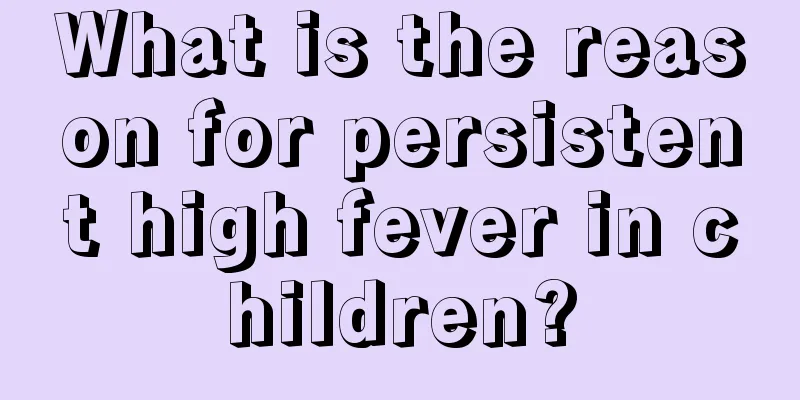What is the reason for persistent high fever in children?

|
In life, babies are prone to fever, but many parents do not understand the cause of their baby's fever. When a baby has a fever, it is easy to cause some other diseases. Therefore, parents must find out the cause of the baby's fever. This can avoid some other diseases and provide timely treatment. So what is the reason for children's persistent high fever? The normal basal body temperature of children is 36.9℃~37.5℃. Generally, when the body temperature exceeds the basal body temperature by more than 1°C, it is considered a fever. Among them, low fever refers to body temperature fluctuating around 38°C, and high fever refers to body temperature above 39°C. Continuous fever for more than two weeks is called long-term fever. The above-mentioned basal body temperature refers to the rectal temperature, which is measured from the anus. Generally, the oral temperature is 0.3℃~0.5℃ lower than the rectal temperature, and the axillary temperature is 0.3℃~0.5℃ lower than the oral temperature. My child had a fever once. It was the same thing. He took the antipyretic medicine and the fever went down after a while. But a few hours later, the fever came back, and this cycle repeated. He was sent to the hospital and had a blood test, and the results showed that the fever was caused by a viral infection. One of the characteristics of a viral infection is recurrent fever. The doctor did not prescribe any antipyretic injections or IV drips, but only prescribed three antiviral injections. After three days, my blood pressure did not rise again. If the fever is above 38.5 degrees, please ask a doctor immediately to confirm whether it is a viral infection or a bacterial infection. If it is a viral infection, use antiviral drugs (such as ribavirin); if it is a bacterial infection, use antibiotics (such as cephalosporins). Do not rush to reduce the fever. The fever is only a symptom and the cause of the disease must be found out. Pay attention to whether there is bacterial or viral infection. The main symptoms and causes are as follows: Fever and runny nose - cold (cold syndrome) Sore throat – pharyngitis, tonsillitis Continuous fever of around 39°C, bloodshot eyes and eye mucus - swimming pool fever Exhaustion and high fever in a hot place - heat stroke (sunstroke) Swollen parotid glands – mumps Ear discharge and emotional instability - otitis media Coughing and difficulty breathing – pneumonia Red gums and excessive saliva - stomatitis Vomiting, cramps, bulging fontanelle – meningitis Vomiting, convulsions, unconsciousness—pneumonia, acute encephalopathy Frequent urination and blood in urine – urinary tract infection Fever and convulsions - heat cramps The above is an introduction to the reasons for persistent high fever in children. Parents must have a relevant understanding of the causes of this type of disease and pay more attention to changes in their children's bodies so that they can take better care of their children. If children have some problems in life, they must choose treatment methods based on the actual situation. |
<<: What is the cause of the fever and convulsions in children?
>>: What to eat for cough caused by cold in children
Recommend
What is the reason for white tongue coating in children?
If a child has a white tongue coating, there may ...
When is the best time to correct children's teeth?
I believe that the problem of tooth deformity is ...
What are the symptoms of purpuric nephritis in children?
Nephritis is harmful to our body. At the same tim...
At what age do children start to change their teeth?
Tooth replacement is something that every child w...
What are the dietary methods for reducing phlegm in babies?
What should you do if your baby has a cold and ha...
What to do if your one-year-old baby has bloating
For one-year-old babies, the digestive function o...
What should I do if my child has paronychia?
Paronychia is a very common disease. This disease...
Conservative treatment of adenoids hypertrophy in children
Adenoids hypertrophy is a disease that many peopl...
How long does it take to treat nephritis in children?
Nowadays, many children suffer from nephritis. Th...
What to do if your child blushes when talking nervously
Many people have experienced blushing when they w...
What is the treatment for sinusitis in children?
Children are also susceptible to rhinitis, so if ...
What is the best way to treat baby eczema?
In this age where most children are only children...
Can six-month-old babies drink yogurt?
Many people like to drink yogurt. The nutritional...
How to cure children's mouth ulcers quickly?
Children's bodies are relatively fragile, whi...
Is it normal for children to lose hair after washing their hair?
Hair loss is common for girls with long hair. Lon...









